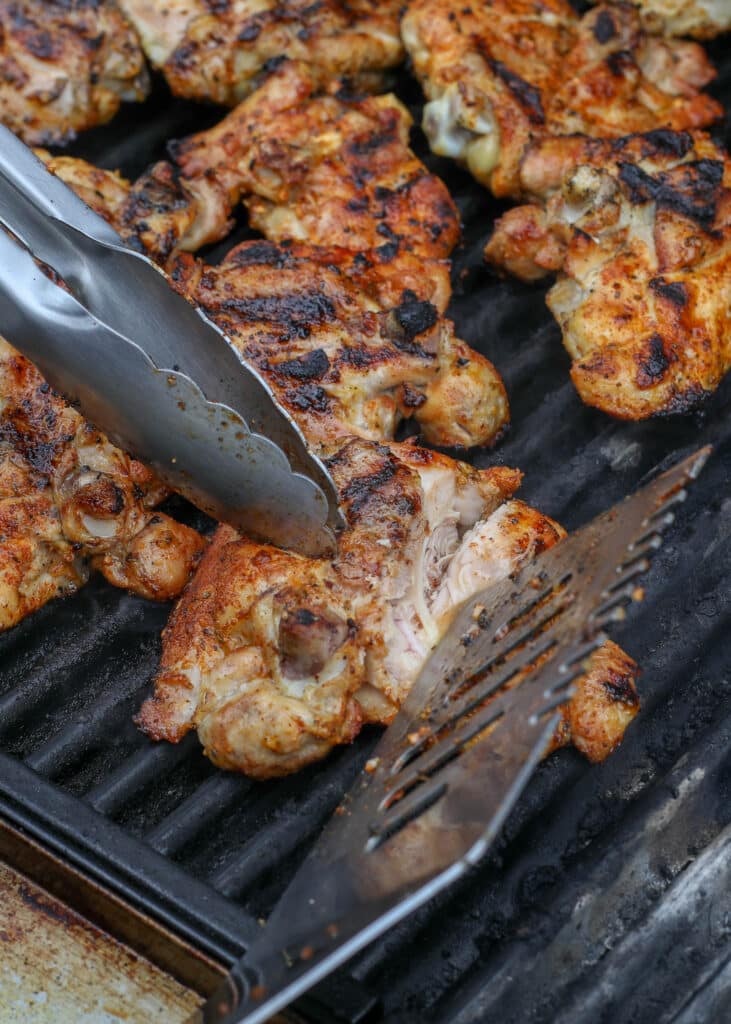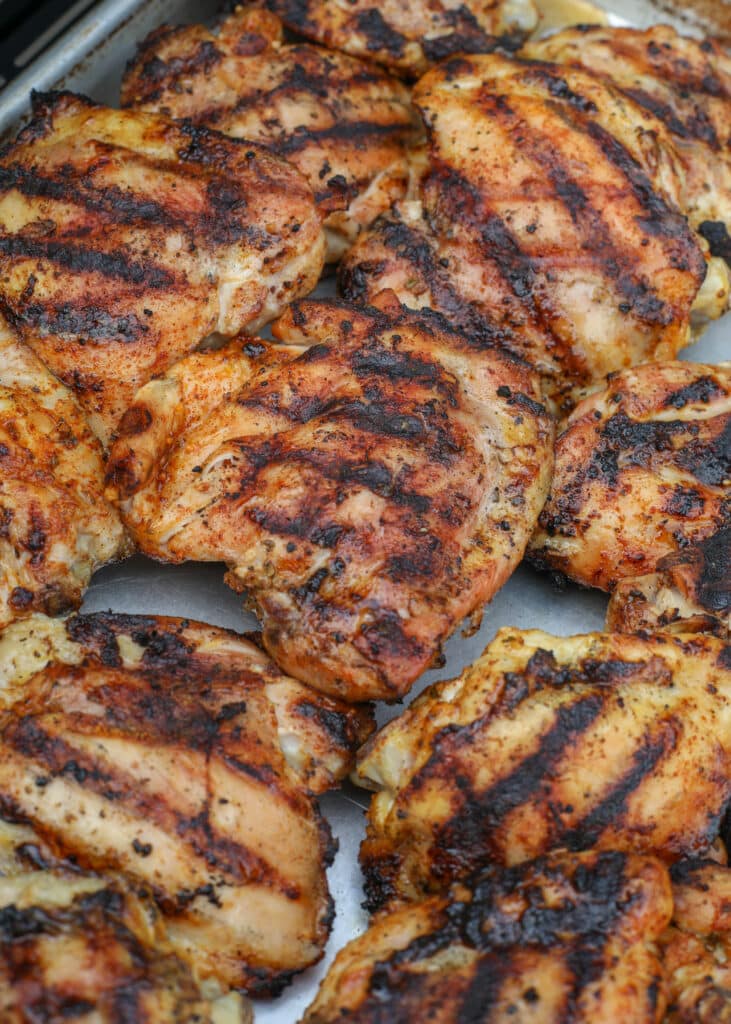Are you tired of ending up with dried-out chicken thighs or, worse, undercooked ones that send everyone running from your BBQ? I’ve been there too! After countless backyard grilling sessions (and some embarrassing failures), I’ve finally mastered the art of perfectly grilled chicken thighs.
Today, I’m sharing everything you need to know about how long to grill chicken thighs at 350°F to achieve that perfect balance of crispy skin and juicy meat that’ll have your family and friends begging for seconds.
The Short Answer: Grilling Time for Chicken Thighs at 350°F
For those who just want the quick answer before their guests arrive:
- Bone-in, skin-on chicken thighs: 30-45 minutes total cooking time
- Boneless, skinless chicken thighs: 15-20 minutes total cooking time
But wait! Don’t run off to your grill just yet. There’s more to perfect chicken thighs than just time and temperature.
Why Chicken Thighs Are the Ultimate Grilling Meat
Before we dive into the specifics, let’s talk about why chicken thighs deserve a special place on your grill
- Superior flavor: The dark meat of thighs is richer and more flavorful than chicken breasts
- More forgiving: The higher fat content means they’re less likely to dry out if slightly overcooked
- Budget-friendly: Thighs are typically cheaper than chicken breasts
- Nutritional powerhouse: Packed with protein, B vitamins, and minerals like phosphorus and selenium
I personally prefer bone-in, skin-on thighs because they offer the most flavor and juiciness. The bone helps conduct heat evenly while the skin crisps up beautifully and protects the meat from drying out.
Essential Equipment for Grilling Chicken Thighs
Before you start, make sure you have these basics:
- A reliable grill (gas or charcoal)
- Long-handled tongs
- Instant-read meat thermometer (absolute must-have!)
- Grill brush for cleaning
- Basting brush if you’re applying sauce
Perfect Step-by-Step Process for Grilling Chicken Thighs
1. Preparation Is Key
Start by patting your chicken thighs dry with paper towels. This step is crucial! Removing excess moisture helps achieve better browning and prevents steaming.
2. Marinate for Maximum Flavor
While you can simply season with salt and pepper, a marinade adds incredible depth of flavor. Here’s my go-to marinade that never fails to impress
¼ cup olive oil½ teaspoon smoked paprika1 teaspoon dried rosemary1-2 cloves minced garlic1 teaspoon saltBlack pepper to taste1 teaspoon Dijon mustard1 tablespoon orange juice1 tablespoon soy sauce1 tablespoon balsamic vinegar1 tablespoon honey or brown sugarMix all ingredients in a bowl, place your chicken thighs in a resealable bag, pour the marinade over them, and refrigerate. For best results, marinate for at least 1 hour, but overnight is even better!
3. Preheat Your Grill Properly
This is where many people go wrong! A properly preheated grill is essential for perfect chicken thighs:
- Clean your grill grates thoroughly
- Preheat to medium-high heat (350°F)
- Create two zones: a direct heat zone and an indirect heat zone (especially important for bone-in thighs)
4. The Grilling Process
Now for the main event! Here’s how to grill your chicken thighs to perfection:
For Bone-in, Skin-on Chicken Thighs:
- Place thighs on the grill skin-side down first over direct heat
- Grill for about 4-5 minutes until you get nice grill marks
- Flip the thighs and grill for another 4-5 minutes
- Move to indirect heat and continue cooking for 20-35 more minutes, depending on size
- Check temperature regularly – you’re aiming for 165°F in the thickest part (avoid touching the bone with your thermometer)
For Boneless, Skinless Chicken Thighs:
- Place thighs over direct heat
- Grill for about 5-7 minutes per side
- Continue until internal temperature reaches 165°F (usually 15-20 minutes total)
5. Let Them Rest!
Once your chicken reaches the target temperature don’t skip this step! Remove the thighs from the grill and let them rest for 5 minutes before serving. This allows the juices to redistribute throughout the meat for maximum juiciness.
Common Mistakes to Avoid
I’ve made all these mistakes so you don’t have to:
- Not preheating the grill properly: Always give your grill 10-15 minutes to heat up
- Cooking at too high a temperature: This leads to burnt outsides and raw insides
- Constantly flipping the chicken: Resist the urge! Flip only once or twice
- Not using a meat thermometer: Never guess when it comes to poultry
- Cutting into the chicken immediately: Let it rest to keep those juices inside
Signs Your Chicken Thighs Are Done
Besides using a thermometer (which is the most reliable method), here are some visual cues:
- Juices run clear when pierced with a fork (not pink)
- The meat has pulled back slightly from the bone
- The skin is crispy and golden brown
- The meat feels firm but still has some give when pressed
Flavor Variations to Try
Once you’ve mastered the basic technique, get creative with these flavor profiles:
Mediterranean Herb:
- Oregano, thyme, basil, lemon juice
- Add sun-dried tomatoes and Kalamata olives
Greek-Style Lemon Oregano:
- Lemon juice, oregano, garlic
- Serve with tzatziki sauce
Honey Sriracha:
- Honey, Sriracha, soy sauce, garlic
- Garnish with green onions and sesame seeds
Smoky Chipotle:
- Chipotle powder, cumin, brown sugar
- Perfect for a Mexican-inspired meal
How to Store and Use Leftovers
If you’re lucky enough to have leftovers (which rarely happens at my house!), store them in an airtight container in the refrigerator for 3-4 days. They’re amazing in:
- Salads
- Grain bowls
- Sandwiches
- Quesadillas
- Pasta dishes
Perfect Side Dishes for Grilled Chicken Thighs
Complete your meal with these complementary sides:
- Grilled vegetables like zucchini, bell peppers, and corn
- Crispy garlic herb roasted potatoes
- Mediterranean orzo pasta salad
- Asian cucumber salad
- Creamy potato salad with bacon
- Marinated tomato salad
Troubleshooting Common Issues
Problem: Chicken is burning on the outside but raw inside
Solution: Your heat is too high. Move chicken to indirect heat and continue cooking at a lower temperature.
Problem: Chicken is taking forever to cook
Solution: Your grill may not be hot enough. Make sure it’s properly preheated to 350°F.
Problem: Skin isn’t crispy
Solution: Make sure you start with dry chicken and grill skin-side down first. Don’t flip too soon!
Problem: Chicken sticks to the grates
Solution: Clean and oil your grates before cooking, and resist the urge to flip too early.
FAQ: Your Burning Questions Answered
Can I use frozen chicken thighs?
Nope! Always thaw completely before grilling for even cooking.
Should I trim the excess fat and skin?
I recommend trimming any overly large pieces of fat or skin that hang off, but keep most of the skin intact for flavor and moisture.
Can I use this same method for chicken breasts?
The timing would be different since breasts cook faster and are more prone to drying out. Stick with thighs for best results with this method.
What if I don’t have a thermometer?
Get one! Seriously, they’re inexpensive and make all the difference. Until then, cut into the thickest part to check – the meat should be opaque with no pink, and juices should run clear.
Final Thoughts
Grilling chicken thighs at 350°F gives you the perfect balance of texture and flavor. Remember that the exact cooking time may vary based on the size of your thighs and your specific grill, but 30-45 minutes for bone-in and 15-20 minutes for boneless is a reliable starting point.
The most important thing? Use that meat thermometer! When it reads 165°F in the thickest part, you’re good to go.
Once you’ve mastered this technique, you’ll never go back to dried-out, flavorless chicken again. Your reputation as the neighborhood grill master is about to skyrocket!

Chicken For A Crowd
This isn’t a recipe where you need to worry about overcrowding. The chicken will cook beautifully whether it’s just a few pieces or when the grill is filled to capacity.
We typically grill at least 10 pounds of chicken each time we grill. Any leftover chicken can be eaten as is for lunches or broken down for other chicken recipes.

How To Know When Chicken Is Done
Chicken should not be dark red or look raw inside when it is done cooking. However, color does not indicate doneness. The USDA has said that even fully cooked poultry can sometimes show a pinkish tinge in the meat and juices.
I highly recommend using a meat thermometer for checking the internal temperature of your chicken.
It’s the easiest and most foolproof way to determine whether or not your chicken is done (and is safe to consume). A meat thermometer can also prevent overcooking your dish resulting in tough, flavorless chicken.
Chicken should be at least 165 degrees Fahrenheit to be safe to eat, so you will know without a doubt when the chicken is done.

Cook’s Note : I like to remove the skin from chicken thighs prior to grilling. It is not a requirement though, the chicken will cook just great with the skin on.
However, the spices absorb so nicely throughout the chicken without the skin and I prefer it that way.
It’s a well-established fact that I love crispy pan fried chicken or oven baked chicken complete with the skin, but when it comes to grilling chicken? Skinless is my favorite.
